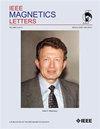A Method of Shear-Horizontal EMAT Based on Dual-Reception Magnetic Encoded Spatial Pulse Compression for Multiple Cracks Identification and Location
IF 1.1
4区 物理与天体物理
Q4 ENGINEERING, ELECTRICAL & ELECTRONIC
引用次数: 0
Abstract
The lowest order mode of a shear-horizontal electromagnetic acoustic transducer (EMAT) typically exhibits a low signal-to-noise ratio and poor spatial resolution in defect detection. To solve this issue, this letter presents a crack identification and location method based on dual-reception magnetic encoded spatial pulse compression technology. On the one hand, the method implements spatial pulse compression technology by adjusting the spatial distribution of the magnetic field to obtain a high amplitude and narrow pulse detection signal. On the other hand, this method multiplexes the excitation EMAT as a receiver through signal processing technology, so that the position of cracks can be more accurately judged by analyzing the signals of the dual EMATs. Most importantly, this method does not require additional EMAT and complex excitation equipment. Finally, a simulation model was built to verify the method. The simulation results show, that compared with the detection signal of the traditional method, the SNR is improved by over 1.1 dB, and the spatial resolution is improved by over 18%. Additionally, the method can effectively distinguish the crack defects on both sides of EMATs, and the localization accuracy exceeds 95%.基于双接收磁编码空间脉冲压缩的剪切水平EMAT多裂纹识别定位方法
剪切水平电磁声换能器(EMAT)的最低阶模式在缺陷检测中通常表现出低信噪比和差的空间分辨率。为了解决这个问题,本文提出了一种基于双接收磁编码空间脉冲压缩技术的裂纹识别和定位方法。一方面,该方法通过调整磁场的空间分布来实现空间脉冲压缩技术,以获得高振幅、窄脉冲检测信号。另一方面,该方法通过信号处理技术将激励EMAT复用为接收器,通过分析双EMAT的信号可以更准确地判断裂纹的位置。最重要的是,这种方法不需要额外的EMAT和复杂的励磁设备。最后,建立了仿真模型对该方法进行了验证。仿真结果表明,与传统方法的检测信号相比,信噪比提高了1.1dB以上,空间分辨率提高了18%以上。此外,该方法可以有效地区分EMAT两侧的裂纹缺陷,定位精度超过95%。
本文章由计算机程序翻译,如有差异,请以英文原文为准。
求助全文
约1分钟内获得全文
求助全文
来源期刊

IEEE Magnetics Letters
PHYSICS, APPLIED-
CiteScore
2.40
自引率
0.00%
发文量
37
期刊介绍:
IEEE Magnetics Letters is a peer-reviewed, archival journal covering the physics and engineering of magnetism, magnetic materials, applied magnetics, design and application of magnetic devices, bio-magnetics, magneto-electronics, and spin electronics. IEEE Magnetics Letters publishes short, scholarly articles of substantial current interest.
IEEE Magnetics Letters is a hybrid Open Access (OA) journal. For a fee, authors have the option making their articles freely available to all, including non-subscribers. OA articles are identified as Open Access.
 求助内容:
求助内容: 应助结果提醒方式:
应助结果提醒方式:


